Are you tired of fighting against roadblocks and limitations that hold back your business's growth?
Do you crave a breakthrough that'll propel your organization to new heights of success?
It's time to give the game-changing theory of constraints (TOC) a go.
TOC isn't just another management philosophy – it's a key that unleashes boundless possibilities.
In this guide, we’ll venture into the heart of TOC, guiding you through its principles and practices. We’ll go over actionable strategies you can put into play immediately and review examples to see this method at work. And we’ll show you how Motion can help to improve this even more.
Let's dig right in.
What is a constraint in a project?
A project constraint is a restriction or boundary that hampers the project's progress or restricts its flexibility. It sets limits on possible achievements within a given timeframe, budget, or available resources.
Constraints actively hinder the project's overall performance and output. They prevent the project from reaching its full potential and meeting its goals efficiently. Failure to identify and manage constraints can lead to delays, increased costs, or compromised quality.
According to PMI, there are six kinds of constraints found within a project. These are:
- Time constraints
- Cost constraints
- Scope constraints
- Quality constraints
- Benefit constraints
- Risk constraints
However, for the TOC, we won’t focus only on these constraints. This is because the TOC can effectively remove constraints and bottlenecks outside those mentioned above. The TOC can also show us a more practical way of evaluating constraints.
For example, let's consider a charity event. Here are some constraints or bottlenecks it might face:
- Limited availability of volunteers
- A fixed date for the event
- Dependence on external vendors for services
As we can see, the constraints here are challenging to fit into any of the six categories. Only number 2 would fit in, begging questions about numbers 1 and 3. Here, numbers 1 and 3 are considered bottlenecks rather than regular constraints.
Constraints vs. bottlenecks
A bottleneck is a specific type of constraint that restricts the flow or progress of a project (or any process). It acts as a point of congestion or delay that limits the project's overall efficiency.
It's important to note that while all bottlenecks are constraints, not all constraints are bottlenecks.
From our previous example, we can clearly see how constraints can cause bottlenecks. In that example, the limited volunteer resources could come from other constraints such as cost, benefit, or scope.
What is the theory of constraints?
Let's connect the dots and see how the TOC builds upon the concepts of constraints and bottlenecks.
Simply put, the theory is a management philosophy and methodology developed by Eliyahu M. Goldratt. Its main goal is to identify and overcome the most critical constraints that hold back a project’s performance.
TOC recognizes that a few key constraints often limit a system’s effectiveness. It’s similar to how a weak link affects a chain’s strength.
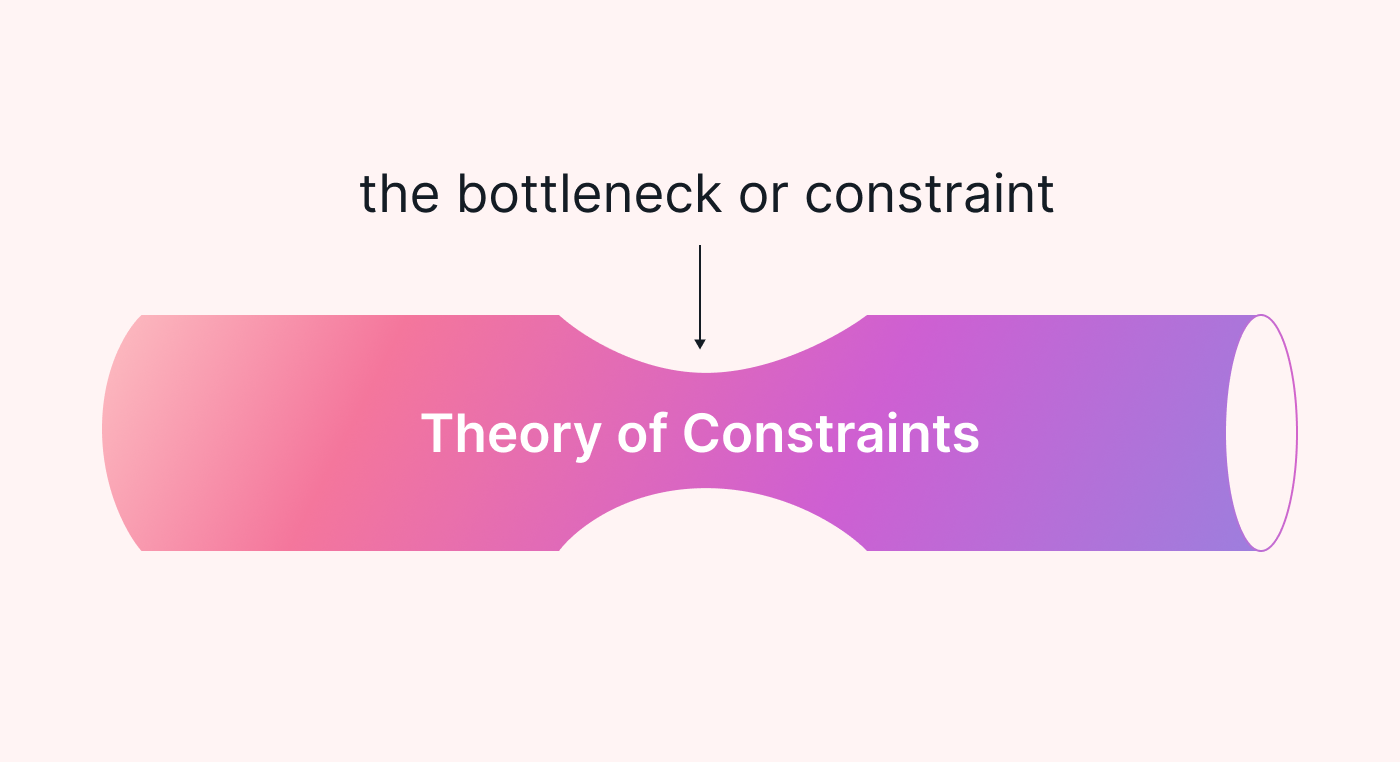 |
As mentioned, constraints hinder a project’s progress and can lead to bottlenecks. However, TOC takes a targeted and systematic approach to deal with these challenges.
TOC tackles constraints head-on, one at a time until the process is free from as many as possible. This allows the system to function optimally, making projects less likely to fail.
The core idea of TOC is to manage constraints and leverage them for continuous improvement. Businesses can use the method to build constraint resilience over time. This is because you can deeply understand how constraints impact operations and what solutions work.
A quick history of the TOC
TOC traces its roots back to the work of Goldratt, an influential figure in the management field. Goldratt’s groundbreaking book, “The Goal,” published in 1984, played a pivotal role in popularizing the TOC method.
“The Goal” presented a fictional story that illustrated the concepts and principles of TOC in a way relatable to any business. This book captured the attention of many business leaders and sparked a movement towards applying TOC.
Since then, TOC has grown and found applications in various sectors, including:
- Manufacturing
- Project management
- Supply chain optimization
- Service-based organizations
- And many other industries
Benefits of using the TOC
Using TOC, you can gain several benefits that improve efficiency and outcomes.
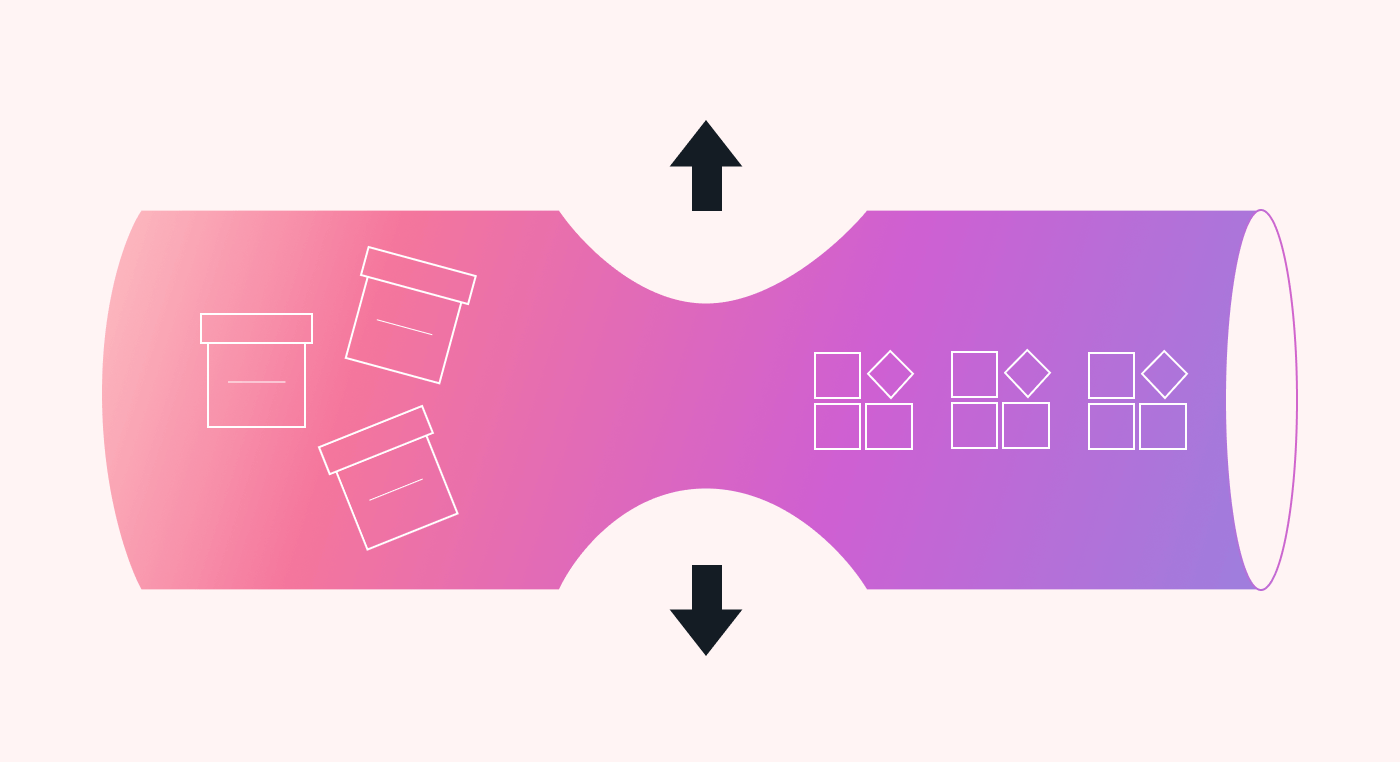 |
TOC helps improve the flow of work in your projects. It does this by removing constraints that can hamper your workflow. This way, you can also optimize resource use and plan better. It also helps with:
- Reduction of lead times.
- On-time delivery.
- More accurately satisfied customer expectations.
- Better execution of projects.
Because of the above reasons, it also has the potential to improve profitability. It can drive your business toward tremendous success and help you achieve your long-term goals efficiently.
Imagine a manufacturing company that implements the TOC core principles. They take out constraints and potential bottlenecks in the manufacturing process. And because of that, they can simplify production and deliver products on time. This makes the manufacturing companies’ customers happy and increases their sales and profitability.
When can you use the TOC?
The theory of constraints is applicable in many industries and situations.
In manufacturing industries, TOC can help optimize the supply chain. It does this by managing constraints and improving the flow of materials. It can also streamline production lines by identifying and addressing bottlenecks and constraints.
Service-based organizations can benefit from TOC because it can help them identify and manage critical constraints. You can then better plan project schedules and how to allocate resources efficiently. This helps with timely delivery and customer satisfaction.
TOC provides a smooth service flow for time-sensitive services like healthcare or transportation. It does this by helping with efficient resource allocation and reducing waiting times. It can also optimize project networks with interconnected tasks.
In event planning, TOC can help manage the various aspects of organizing a successful event. Here it can help to plan and manage constraints such as limited venue capacity or logistical challenges.
TOC is especially useful in scenarios with frequent bottlenecks, like traffic planning. It identifies and addresses constraints to improve efficiency and productivity. It also helps businesses adapt to demand fluctuations by capacity planning effectively.
Here's a breakdown of other situations where it can be helpful in:
- In the construction industry, it can help to manage complex projects with multiple dependencies
- Retail businesses can apply TOC to optimize their supply chain and inventory management
- In software development, TOC can help manage project schedules and resource allocation
- In healthcare organizations, TOC can be applied to optimize patient flow and resource use
- In educational institutions, TOC can assist in managing classroom schedules and resources
Apply the TOC in project management
The TOC approach can significantly enhance project outcomes and efficiency in project management. In this environment, you should actively identify and address or “exploit” constraints.
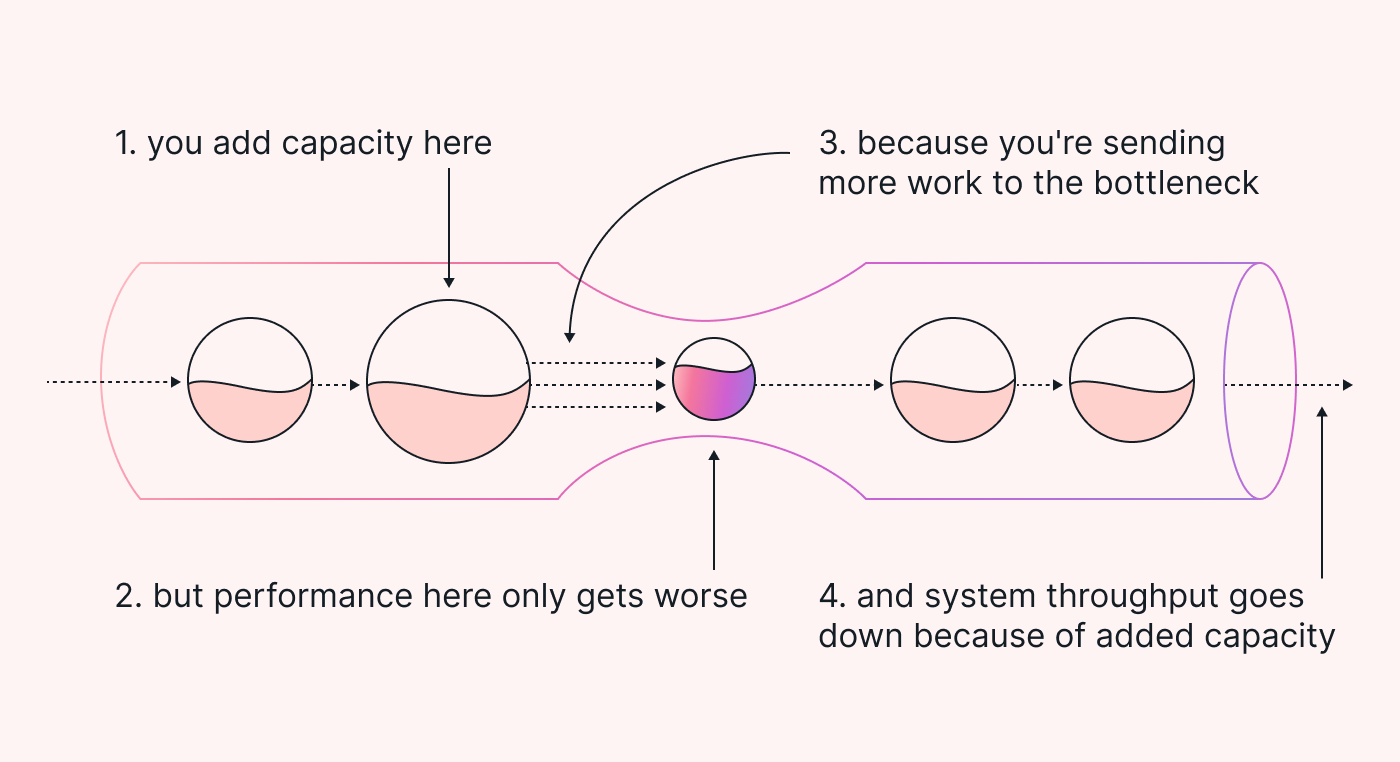 |
An important part of this is analyzing dependencies. With this knowledge, project managers can identify critical paths and potential bottlenecks. Another key is actively optimizing resource usage. This way, the best resources are in use, the delays are kept to a minimum, and productivity gets a boost.
Let's consider a construction project as an example. The project manager actively identifies the constraint of skilled workers' availability. Because of this, they can prioritize tasks dependent on these skilled workers and assign resources accordingly. This provides a smooth project progression without resource-related delays.
Implementing TOC in project management involves a few practical strategies. Two very effective frameworks can help manage constraints:
- Project managers can use techniques like critical chain project management (CCPM). CCPM is useful for addressing constraints and managing project schedules. This approach includes buffer management, where you strategically allocate additional time-to-critical paths. This is to account for uncertainties and ensure you finish the project on time.
- Visual tools like Gantt charts or Kanban boards are also valuable when applying TOC. They help to visualize the project flow, identify constraints, and monitor progress.
TOC 5 steps for removing constraints
Implementing the TOC involves a systematic process of removing constraints to optimize performance. With these five steps derived from the method, you can improve efficiency and achieve better outcomes.
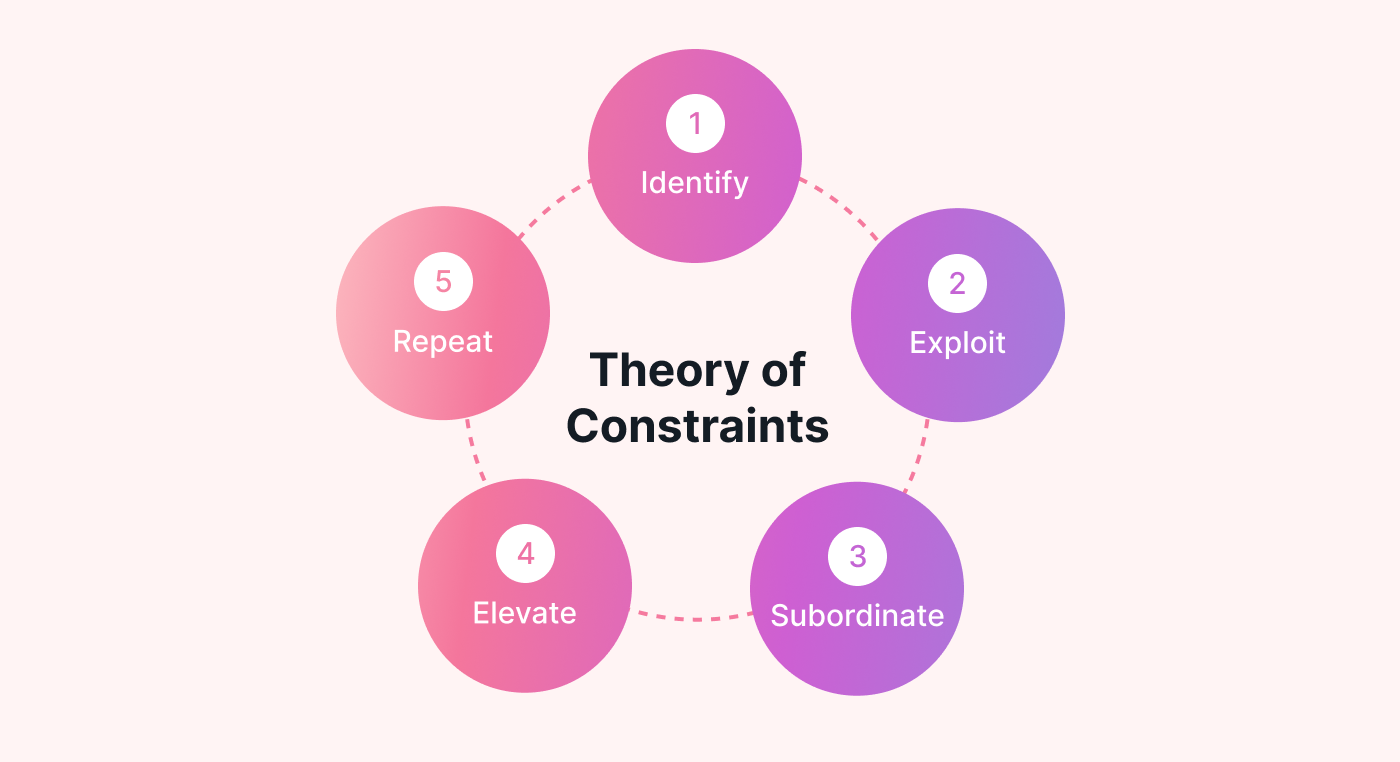 |
Let’s dig right in.
Identify the constraint(s)
The first step is identifying the key constraints limiting performance. This could be a bottleneck in the process, a limited resource, or any other constraints we mentioned.
For example, a machine with a slower processing speed in a manufacturing plant could be a constraint.
A good way to identify these constraints is with visual tools like a Gantt chart, timeline, or process map.
Exploit the constraint(s) to maximize its utilization
Once you know what the constraint is, you should exploit it to its fullest potential. This involves making sure that the constraint is always in operation.
For instance, in a software project, if the availability of skilled developers is the constraint, project managers will assign the developers to critical tasks. They'll also prioritize their workload to maximize their output.
Subordinate other activities to the constraint(s)
To achieve system harmony, you should align non-constraint activities with the constraint. This helps with a smooth flow of work and avoids overburdening the constraint.
Imagine that a call center's limited staff capacity is the constraint. The managers will schedule shifts and allocate resources to align with the constraints' capacity.
Elevate the constraint(s) if necessary
If those aren't enough to meet the desired performance level, you need to consider elevating the constraint. This could involve investing in additional resources, upgrading equipment, or acquiring new tools.
For instance, a transportation company might expand its fleet to address the constraint of limited vehicle capacity.
Continuously improve the system by going back to step one
Improvement is an ongoing process. Once you have fixed a constraint, another step in the process may become the new constraint. You should continually reassess and revisit the steps to identify new constraints and opportunities.
With this practice, you can drive continuous improvement and maintain an optimized system.
TOC thinking process
In the TOC, we use thinking processes as an active problem-solving approach that helps us tackle complex challenges.
Using thinking processes involves capturing symptoms or undesirable effects and organizing them into tree diagrams. We can then visually map the cause-and-effect relationships of these symptoms or effects.
A critical aspect of thinking processes is the concept of layers of resistance. These layers represent individual perceptions of why things aren’t working optimally. They can help us overcome biases and preconceived notions. This perspective allows us to find more accurate solutions and opens us up to new ideas.
Another idea is to use the thinking process for team thinking. We could almost call this a “group thinking process.” In group settings, team members can come together to identify core constraints and share their opinions and insights. Here, the goal is for the team to have those “ah-ha” moments and uncover breakthrough solutions.
Now, let's explore some of the key TOC thinking process tools:
- Current reality tree: This tool helps us capture and arrange the undesirable effects we have identified. With cause-and-effect relationships identified, we can better plan to handle it.
- Future reality tree: With this tool, we can document our desired state and propose new ideas, or injections, to create positive effects. It allows us to envision a future where the core problem is removed or significantly improved.
- Negative branch reservations: As we suggest new ideas, concerns and objections may arise. This tool helps us address those reservations. Making sure that potential obstacles or risks are thought of or handled.
- Evaporating cloud tree: This tool helps us explore the conditions necessary for our injections to succeed. Or it can find win-win solutions to conflicts. It allows us to challenge underlying assumptions and beliefs limiting our progress.
- Strategy tree and tactics tree: These tools help us diagram the actions and steps needed to implement our identified solutions. They provide a roadmap for bringing about improvements and achieving our desired outcomes.
Using Motion with the TOC
Motion not only simplifies your life by streamlining your schedule but can also work together with the theory of constraints. By combining the power of Motion’s intelligent calendar management with the principles of TOC, you can take your efficiency to new heights.
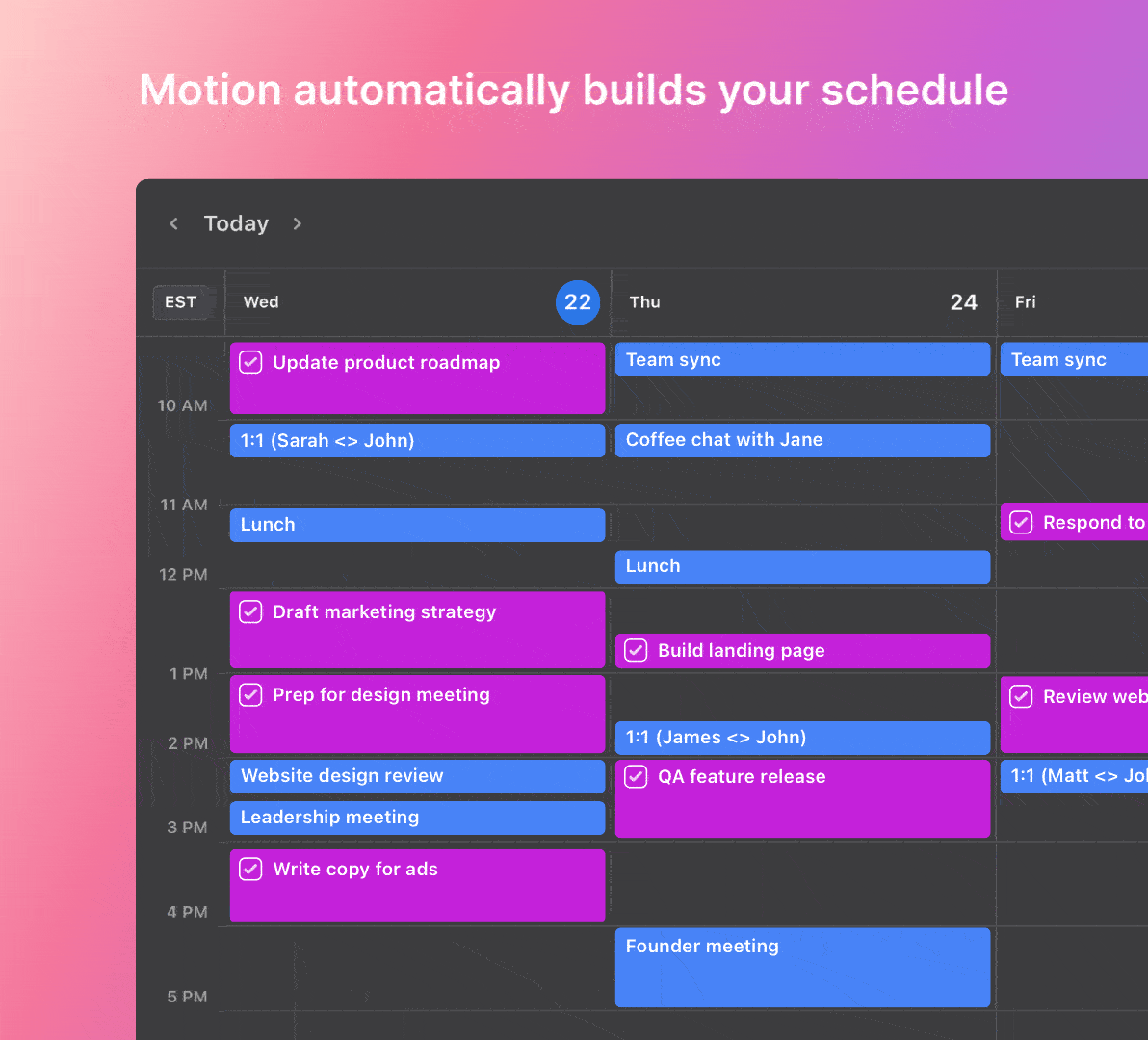 |
Motion’s task management features align perfectly with TOC’s approach to optimizing resource allocation and managing critical paths.
And with Motion, you can visualize workflow processes using Kanban boards or project timelines.
Start your 7-day free trial now.





